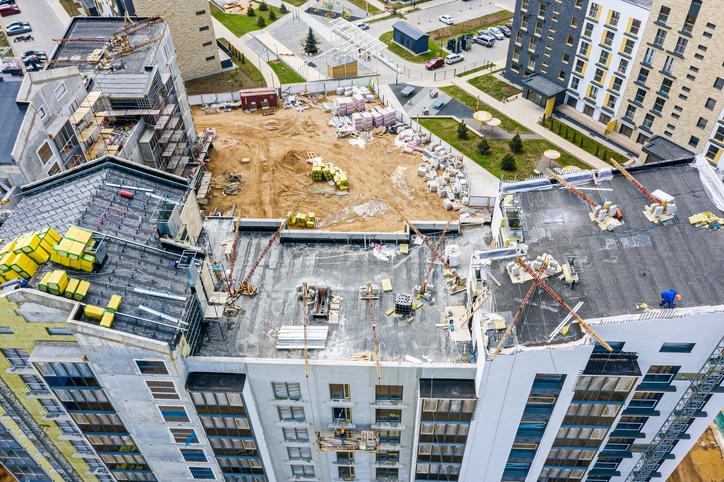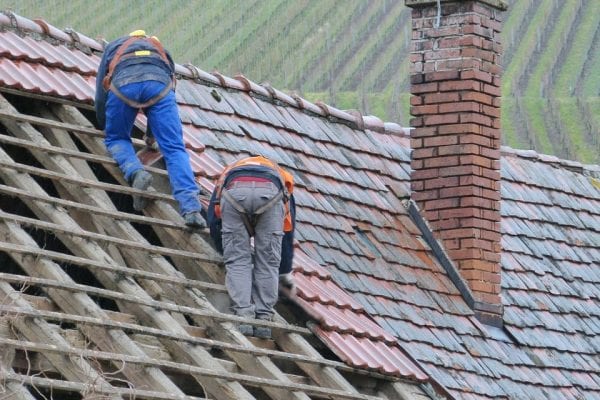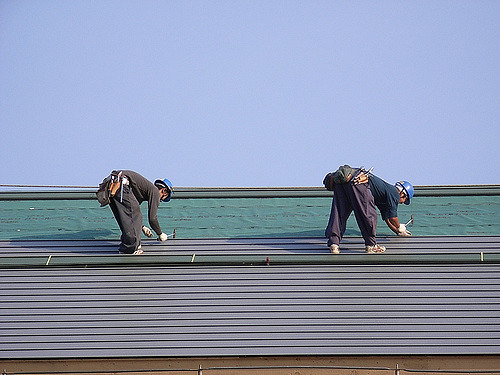The roof is one of the most important, and also one of the most expensive, components of any building. For that reason, when a problem arises, the building owner should first consider whether to repair rather than replace. Understanding the primary cost factors involved in a commercial roof replacement can help in that decision, as well as in deciding what type of replacement to choose and how much to budget.
In this article, we’ll discuss the top five factors that will impact the cost of your commercial roof replacement:
- Type of roof
- Roof access
- What’s underneath
- Wind loads and fastenings
- Code requirements
Type of Roof
There are two main categories of commercial roofs:
- Flat (also called low-slope)
- Sloped
In the majority of cases, the best roofing material for a flat roof is either a single-ply roof or built-up bituminous roofing. Viable single-ply materials first became available for flat roofs about 25 years ago. At that time, many people were concerned that a single layer of protection would be prone to leaks. Over time, these roofs have proven to be incredibly durable and often come with a 25-30 year warranty. They are often less expensive and time-consuming to install than other types of flat roof materials.
Typical cost for single-ply flat roof replacement: $11 to $14 per square foot.
As the name implies, built-up bituminous roofing consists of a number of layers of various roofing materials built-up, one over the other. They provide the protection of multiple layers of roofing plies, but can be more expensive and time-consuming to install.
Typical cost for built-up bituminous flat roof replacement: $11.50 to $14.50 per square foot.
Sloped roofs provide a larger variety of options for coverings. Typically, the cheapest covering is asphalt shingle. Additional options include slate or wood shingles, however, some of these materials can be expensive. With shingled roofs, aesthetics should also be considered, as the visible roofs can be a significant part of the overall look of the building.
Typical cost for asphalt shingle roof replacement: $3.50 to $7 per square foot.
Tiles are another common covering for sloped roofs. They come in clay, concrete, and other materials. They are typically long-lived materials, some lasting as long as 50 years. However, they are also one of the most expensive materials.
Typical cost for barrel tile roof replacement: $6.50 to $18 per square foot.
A third common material for sloped roofs is metal. Metal roofs come in many varieties–corrugated, standing seam, and flat seam, as well as in many colors. Metal roof technology has come a long way in terms of aesthetics. They can be made to look like other types of roofs, and the colors now remain true for the life of the roof.
Typical cost for metal roof replacement: $7 to $15 per square foot.
It’s important always to balance warranty and estimated useful life (EUL) against the up-front savings of various roofing products. While warranties of varying durations can be obtained for the differing roofing products, you should remember that a warranty is essentially a roofing insurance policy, and like any insurance, you can purchase the coverage limits you are willing to pay for. That said, many roofing warranties are pro-rated, so even if you purchase a long duration warranty, the amount reimbursed to you from a warranty claim may only be pennies-on-the-dollar versus the value of a full replacement.
Each roof system has a realistic EUL based on the materials it is comprised of, and the climate it is installed in. When evaluating life-cycle costs, it is best to consider the realistic EUL of the roof as opposed to the perceived value of a roof warranty.
Roof Access
Roof access can have as much impact on the cost to replace your roof as the type and material. Accessibility factors include:
- Height
- Material storage areas
- Occupancy
- Property access
A 20-story building will be much more costly to reroof than a 2-story building, due to the need for cranes to lift materials. Likewise, for a large roofing project, it may be necessary to store large amounts of material. Wide open “lay down” areas near the building can make logistics easier, thus lowering the cost.
A building that is occupied will pose additional challenges to the roofing project. The health, safety, comfort, and productivity of occupants must be taken into account. If this mandates the roof replacement activities take place beyond normal working hours, additional costs will likely be incurred. Finally, the ability to get equipment into the property and close to the building will play a part in cost.
What’s Underneath
Under every finished roof is a combination of one or more components:
- Roof structure, which may be a concrete, metal or wood deck
- Insulation
- Cover board
- Other substrate materials
The condition of these materials will impact your reroofing cost. If there is a great deal of water or impact damage, and these materials need to be replaced, the cost will be higher. In some cases, an experienced roofing consultant or contractor can identify areas needing repair by the “feel” of the roof. More often though, infrared technology or other moisture detecting equipment will more accurately help identify trapped moisture. That said, in most cases you won’t know for sure the cost impact associated with damaged substrate materials until after the old materials are removed.
Fasteners and Wind Loads
Depending on where your building is located, weather and local codes will impact the type of fasteners your roof system requires. In Florida, buildings must be designed to withstand up to 150-mile per hour winds. This requires stronger fasteners at more frequent intervals than some other areas might require.
Code Requirements
Besides fasteners and wind loads, there are many other local, regional, and state code requirements that your building may be subject to. These can impact everything from insulation and substrate to ventilation and slope.
These five factors are not the only matters that will affect the cost of your commercial roof replacement, but they’re useful to know when developing a ballpark price estimate. When you run into a problem with your roof, consider hiring a reputable roofing consultant to help you determine the most cost-effective solution, whether a repair or a replacement.
Call GLE now to schedule your initial consultation.






